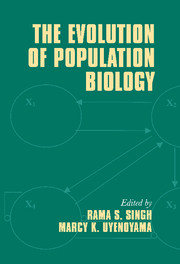Book contents
- Frontmatter
- Contents
- List of contributors
- Publications of R. C. Lewontin
- Preface
- Introduction
- Part I Historical foundations and perspectives
- Part II Genotypes to phenotypes: new genetic and bioinformatic advances
- Part III Phenotypes to fitness: genetics and ecology of populations
- 7 Density-dependent selection
- 8 Nonsynonymous polymorphisms and frequency-dependent selection
- 9 Why k = 4Nus is silly
- 10 Inferences about the structure and history of populations: coalescents and intraspecific phylogeography
- 11 The population genetics of life-history evolution
- 12 Gene–environment complexities: what is interesting to measure and to model?
- 13 Genus–specific diversification of mating types
- Part IV Genes, organisms, and environment: evolutionary case studies
- Part V Applied population biology: biodiversity and food, disease, and health
- Index
13 - Genus–specific diversification of mating types
Published online by Cambridge University Press: 08 January 2010
- Frontmatter
- Contents
- List of contributors
- Publications of R. C. Lewontin
- Preface
- Introduction
- Part I Historical foundations and perspectives
- Part II Genotypes to phenotypes: new genetic and bioinformatic advances
- Part III Phenotypes to fitness: genetics and ecology of populations
- 7 Density-dependent selection
- 8 Nonsynonymous polymorphisms and frequency-dependent selection
- 9 Why k = 4Nus is silly
- 10 Inferences about the structure and history of populations: coalescents and intraspecific phylogeography
- 11 The population genetics of life-history evolution
- 12 Gene–environment complexities: what is interesting to measure and to model?
- 13 Genus–specific diversification of mating types
- Part IV Genes, organisms, and environment: evolutionary case studies
- Part V Applied population biology: biodiversity and food, disease, and health
- Index
Summary
Introduction
Self-in compatibility (SI) discourages self-fertilization in many hermaphroditic plants by causing the rejection of pollen that express genetically encoded specificities in common with the pistil. In the best-studied systems, a single region (S-locus) determines mating specificity in both pollen and pistil. Because pollen that express rarer specificities encounter rejection at lower rates, SI engenders intense balancing selection, maintaining dozens of S-alleles within local populations.
While the estimation of genealogical relationships among taxa is paramount in many phylogenetic studies, our primary objective here is to elucidate the evolutionary history of SI. This objective is served through the analysis of topology (pattern and order of branching) and genealogical shape (relative sizes of various features of the tree). Several likelihood- or momentbased methods for the estimation of demographic parameters under specified models have recently been developed (for example, Takahata et al. 1995, Yang 1997, Wakeley and Hey 1997, Nielsen 1998, Bahlo and Griffiths 2000, Beerli and Felsenstein 2001). Along a different tack, Hey (1992) and Nee et al. (1994) have based the inference of the rate of origin and extinction of taxa on the pattern of intervals between nodes in gene genealogies. Indeed, as Holmes et al. (1999) indicate, these methods seek to examine tree shape without having to estimate fundamental quantities such as Nu (product of effective population size and mutation rate).
- Type
- Chapter
- Information
- The Evolution of Population Biology , pp. 254 - 272Publisher: Cambridge University PressPrint publication year: 2004
- 2
- Cited by



